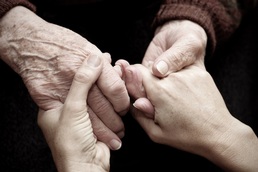Frailty syndromes should be recognised to prevent older people from significant harm

Community services should shift their focus from those at a ‘high risk of hospital admission’ to those with a frailty syndrome to reduce hospital bed usage, according to new guidance published this week.
‘Fit for Frailty Part 2’ has been launched by the British Geriatrics Society (BGS) with support from Age UK and Royal College of General Practitioners and follows ‘Fit for Frailty Part 1’ released in June 2014.
Commissioners are being called on to prioritise preventative support for older people and more integration between different services. Fit for Frailty Part 2 also wants more detailed assessments of the needs of older people with frailty to be carried out and the document provided evidence to show how this can work in practice.
The guidance reveals only half of people in the UK with a frailty syndrome receive effective health care interventions, despite revealing evidence which suggests that focusing community services on people with frailty instead of those who are at a high risk of hospitalisation would improve the quality of patient care.
Dr. Gill Turner, BGS vice president, clinical quality, and Fit for Frailty Project group lead said: “As a group, ‘older people with frailty’ includes a diversity of individuals, each with different expectations, hopes, fears, strengths and abilities, as well as different types and levels of need and support.
“There is a risk of significant harm to patients with frailty if health interventions are planned for them in the absence of recognition of their frailty. It is the job of clinicians and service providers to ensure that individual differences are, as far as is possible, accommodated, thus restoring control, preserving dignity and facilitating person-centred care to the older person living with frailty and those close to them.
"‘Fit for Frailty Part 2’ aims to be an invaluable resource for all GPs, geriatricians, health service managers, social service managers and commissioners of services, helping them to provide integrated person-centred services for the frail older people in their care.”
An estimated 25 – 50 per cent of people aged 85 and over has some sort of frailty, and 10 per cent of people over 65 are also living with a frailty syndrome.
The guidance explored a number of case studies showing good practice in action including the EASYCare project used by Warwickshire Age UK.
A pilot of the EASYCare project invited patients over the age of 75 to complete an EASYCare assessment that highlighted their needs and potential health issues at an earlier stage and were signposted to the correct services. Carried out by volunteers and Age UK coordinators, the pilot had a response rate of over 50 per cent patients reporting feeling empowered and informed after participating.
Commissioners and providers also benefitted from the pilot by gaining information to help them understand where and how to improve services and target resources for older people.
Prof. John Young national clinical director for integration and frail elderly at NHS England, and member of the Fit for Frailty working group, said: “Services which properly take into account the needs of older patients with frailty are already successful realities throughout the UK, but they are far from widespread. This guidance aims to help commissioners build on those examples, and make them routine throughout the NHS.
“A robust community-based response to older people who have frailty will be essential if we are to meet the challenges posed by an ageing population. Fit for Frailty Part 2 will be a key part of making that goal a reality”.
Caroline Abrahams, charity director at Age UK, said: “At the moment older people who are living with frailty too often end up in a crisis situation with no other choice but to be admitted into hospital or a care home. By being proactive and taking account of the needs of the whole person, the crisis could be prevented and longer-term quality of life improved.”
“As our population ages the chances are that more of us will be living with frailty, meaning the need to ensure everyone is supported to maintain their independence and able to access high quality health and care services, is greater than ever. ‘Fit for Frailty Part 2’ not only offers health professionals guidance on preventative support but also looks at better ways to commission health services. It shows that by listening to people and better understanding the challenges they face day to day, services can work with individuals to find the best solutions and make sure they get the right support.”
Latest News
 29-Jul-24
Dementia Bus gives carehome.co.uk staff insight into life with dementia
29-Jul-24
Dementia Bus gives carehome.co.uk staff insight into life with dementia
 01-Mar-24
Find out the top care homes in 2024
01-Mar-24
Find out the top care homes in 2024
 21-Mar-23
UK's top care homes in 2023 revealed
21-Mar-23
UK's top care homes in 2023 revealed
 03-Jan-23
carehome.co.uk launches free care helpline
03-Jan-23
carehome.co.uk launches free care helpline
 13-Dec-22
5 mins with Emily Whitehurst, chief operating officer for Constantia Healthcare
13-Dec-22
5 mins with Emily Whitehurst, chief operating officer for Constantia Healthcare